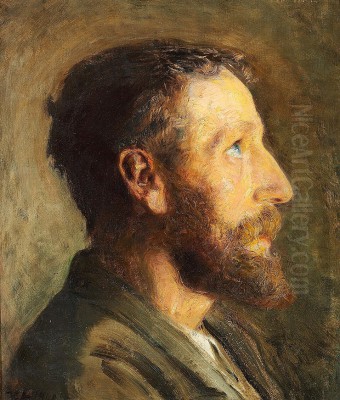
Laurits Andersen Ring stands as one of Denmark's most significant painters, a pivotal figure bridging the 19th and 20th centuries. His work, deeply rooted in the Danish landscape and the lives of its people, masterfully blends Realism with Symbolism, creating a unique artistic language that captured a nation in transition. Born Laurits Andersen in 1854, he later adopted the name of his native village, Ring, in southern Zealand, forever linking his identity to the rural soil that would become central to his art. His long and productive career, spanning from the late 1870s until his death in 1933, left an indelible mark on Danish art history, offering profound insights into the human condition, the cycles of nature, and the social realities of his time.
Ring's paintings are more than mere depictions; they are quiet meditations on existence, often imbued with a sense of melancholy, stoicism, and profound psychological depth. He chronicled the lives of farm laborers, artisans, and the rural poor with an empathy born of his own humble origins, while simultaneously exploring universal themes of life, death, love, and the passage of time through subtle symbolic elements woven into his realistic portrayals. He was a pioneer, navigating the currents of European art while forging a path distinctly his own, becoming a cornerstone of Danish cultural heritage.
Early Life and Formative Years
Laurits Andersen was born on August 15, 1854, in the small village of Ring, near Præstø in South Zealand, Denmark. His family background was modest; his father, Anders Olsen, was a carpenter and wheelwright, and his mother, Johanne Andersdatter, hailed from a smallholding farming family. This upbringing instilled in him a deep understanding and appreciation for rural life and the value of manual labor, themes that would resonate throughout his artistic career. The landscape of South Zealand, with its fields, farms, and changing seasons, became an integral part of his visual and emotional vocabulary.
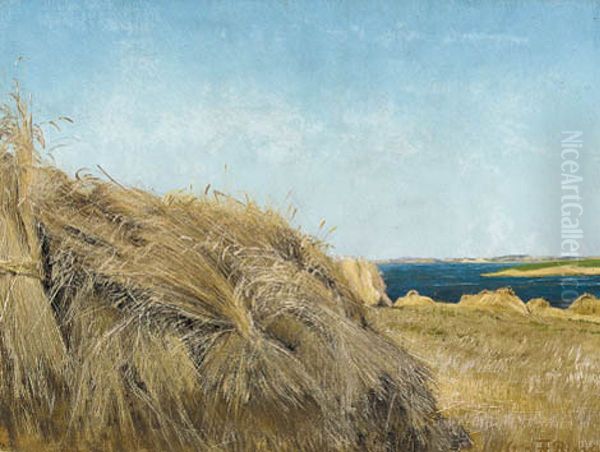
His initial path was not directed towards art. Following the practical expectations of his background, Ring began an apprenticeship as a house painter and later as a carpenter in 1869. However, a growing interest in drawing and painting led him to pursue artistic training. In 1873, he decided to dedicate himself to art, taking lessons locally before applying to the prestigious Royal Danish Academy of Fine Arts in Copenhagen.
Ring was admitted to the Academy in 1875. He studied there intermittently until 1877 and again briefly in the early 1880s. The Academy provided foundational training, but Ring, like many artists of his generation across Europe, found the rigid, classical curriculum somewhat stifling. He felt it was disconnected from the realities of modern life and the expressive possibilities he sought. His time at the Academy was marked by a degree of dissatisfaction, pushing him towards independent study and the development of a more personal style, influenced more by direct observation and contemporary European trends than by academic dogma.
During his student years, he formed important friendships, notably with Hans Andersen from the village of Brendekilde on the island of Funen. To avoid confusion, as both shared the common surname Andersen, they decided in 1881 to adopt the names of their respective birthplaces. Thus, Laurits Andersen became L.A. Ring, and Hans Andersen became H.A. Brendekilde. This act signified not just a practical solution but also an embrace of their rural roots as a core part of their artistic identity. Brendekilde himself would become a notable painter associated with Social Realism and depictions of rural life.
The Emergence of a Unique Voice
The 1880s were a crucial period for Ring's development. Leaving the formal constraints of the Academy behind, he began to forge his distinct artistic path. This era in Danish art was part of the 'Modern Breakthrough' (Det Moderne Gennembrud), a period characterized by a turn towards Realism and Naturalism, influenced by French art and literature, and a desire to depict contemporary life and social issues truthfully. Figures like the critic Georg Brandes championed this movement, urging artists and writers to engage with the problems of modern society.
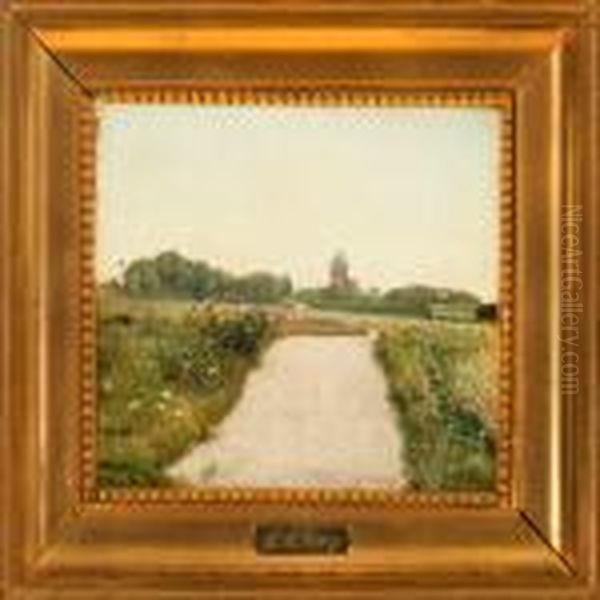
Ring absorbed these influences but filtered them through his own sensibility. His early works show a commitment to realistic depiction, focusing on the landscapes and people of rural Zealand. He painted farm workers, village scenes, and portraits with meticulous attention to detail and a sober palette. Unlike the often sunnier depictions of the Skagen Painters, such as P.S. Krøyer or Michael and Anna Ancher, who captured the coastal light and bourgeois leisure further north, Ring's work often possessed a more grounded, sometimes somber, quality, reflecting the toil and hardships of agricultural life.
His painting The Railway Guard (Banevogteren), completed in 1884, is an early masterpiece that exemplifies his emerging style. It depicts a lone railway guard standing beside the tracks that cut through the flat Danish landscape under a vast, grey sky. The figure is weathered, his posture suggesting patience and perhaps resignation. The painting speaks to the encroachment of modernity (the railway) into the traditional rural world, a recurring theme in Ring's work. It combines sharp realism with an underlying mood of contemplation and isolation.
During this period, Ring faced financial difficulties, a common struggle for artists outside the established system. He supplemented his income with various jobs and relied on the support of friends and patrons. He participated in social gatherings, like those hosted by Christian Clausen, which allowed him to network within the Copenhagen art scene and meet figures like the art dealer Peter Magnussen, who would become important for his career. Despite hardships, his commitment to his artistic vision remained unwavering.
A significant personal event during this time was his unrequited love for Johanne Wilde, the wife of his friend, the lawyer and amateur painter Alexander Wilde. This emotional turmoil is believed to have contributed to periods of depression that Ring experienced throughout his life. This personal melancholy arguably infused his work with a deeper layer of psychological complexity and sensitivity to the nuances of human emotion, even when depicting seemingly straightforward scenes.
Symbolism and the Danish Soul
While rooted in Realism, Ring's art increasingly incorporated Symbolist elements, particularly from the late 1880s onwards. Symbolism, as an international movement, sought to express deeper meanings, emotions, and ideas beyond surface appearances, often using suggestive imagery, metaphors, and ambiguous narratives. Ring's Symbolism was not overtly mystical or fantastical like some European counterparts, such as Gustave Moreau or Odilon Redon. Instead, it was subtle, integrated seamlessly into his realistic depictions of Danish life and landscape.
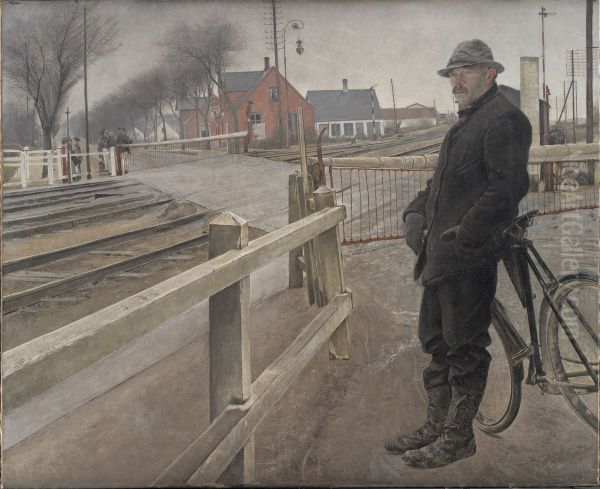
Ring used the familiar elements of the Danish countryside – roads, thresholds, windows, the changing seasons, the cycle of life and death – as vehicles for symbolic meaning. Roads often represent journeys, life paths, or transitions. Thresholds and doorways, like in his famous painting At the French Windows, The Artist's Wife (Ved Frokostbordet og Haverdøren, Kunstnerens Hustru) from 1897, suggest a boundary between the inner, domestic world and the outer world, or between life and the unknown beyond.
His landscapes often carry symbolic weight. The starkness of winter could symbolize hardship or death, while spring might represent renewal and hope. The vast, open skies in many of his paintings evoke feelings of eternity, solitude, or the overwhelming power of nature compared to human existence. He was particularly adept at capturing specific qualities of light – the crisp clarity of a winter day, the hazy warmth of summer, the melancholic glow of twilight – using them to enhance the mood and symbolic resonance of his scenes.
Summer Day by Roskilde Fjord (Sommerdag ved Roskilde Fjord), painted in 1900, is perhaps Ring's most celebrated Symbolist work and is included in the Danish Culture Canon. It depicts his wife, Sigrid Kähler (whom he married in 1896), standing pregnant on a jetty, looking out over the fjord. The painting is a complex meditation on life, fertility, and the passage of time, set against a backdrop that subtly hints at mortality (the calm water, the distant shore). The composition, with its strong horizontal lines and the solitary figure, creates a sense of profound stillness and contemplation.
Other works, like Spring (Forår), also featuring Sigrid, connect the human life cycle with the cycles of nature. Ring's Symbolism often explored the tension between tradition and modernity, the relationship between humanity and nature, and the fundamental questions of existence, all grounded in the specific context of Danish rural life at the turn of the century. His approach influenced other Danish Symbolists like Ejnar Nielsen, though Ring's style remained uniquely his own.
Chronicler of Rural Life: Social Realism
Alongside his Symbolist explorations, Ring remained deeply committed to Social Realism throughout his career. His depictions of rural laborers and the conditions of their lives are among the most powerful in Danish art. Having come from a working-class background himself, he portrayed these subjects with authenticity and dignity, avoiding romanticization or overt sentimentality. He saw the beauty and hardship in everyday toil.
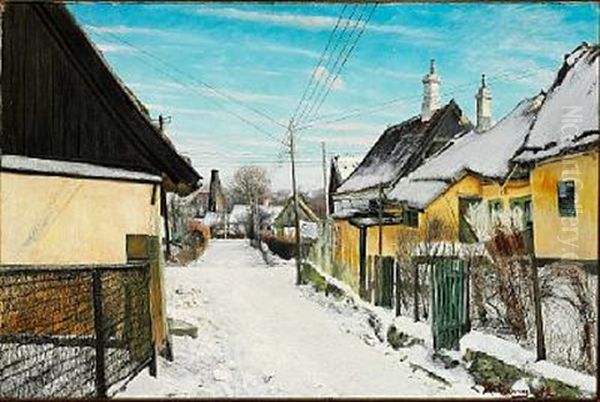
His paintings often focus on specific tasks: harvesting, digging drainage ditches, road mending, working at a tilery. Harvest (I Høst), painted in 1885, shows farm workers gathering sheaves of grain under a vast, luminous sky. The figures are bent to their task, their bodies conveying the physical exertion involved. While celebrating the timeless rhythm of agricultural work, the painting also subtly hints at the vulnerability of those dependent on the land and the weather. It echoes the work of French Realists like Jean-François Millet, whom Ring admired, but with a distinctly Danish sensibility and light.
Another powerful example is Workers Laying a Water Pipe to Sønderved (Arbejdere ved en Vandledning ved Søndersø). Here, the focus is on the collective effort of laborers engaged in a modern infrastructure project. Ring captures the muddy reality of the work, the strained postures, and the camaraderie among the men. It reflects the ongoing modernization of the Danish countryside and the physical labor underpinning these changes.
Ring's social consciousness extended beyond just depicting labor. He was politically aware and sympathetic to the struggles of the working class and the rural poor. In his youth, he was involved with the "Rifle Movement" (Riffelbevægelsen), a student group with revolutionary leanings that practiced armed training in preparation for potential social upheaval, reflecting the political tensions of the time. While he didn't become an overt political propagandist in his art, his choice of subjects and his empathetic portrayal clearly signaled his social concerns.
Paintings like The Drunkard or Outside the Tavern (Den Drukne, Udenfor Kroen) tackle social marginalization directly, depicting an outcast figure with stark realism. His interest was not just in the picturesque aspects of rural life but also in its social fabric, including poverty, inequality, and the impact of societal changes. He documented a way of life that was gradually disappearing with increasing industrialization and urbanization, preserving it with honesty and artistic integrity.
Masterpieces and Key Themes
Ring's oeuvre is rich with masterpieces that encapsulate his key themes and stylistic innovations. Analyzing a few key works reveals the depth and consistency of his vision.
The Railway Guard (Banevogteren, 1884): As mentioned, this early work establishes Ring's interest in the intersection of tradition and modernity. The solitary figure, the stark landscape divided by the railway line, the muted colors, and the expansive sky create a powerful image of quiet endurance and the subtle transformation of the Danish landscape. It speaks to themes of isolation and the individual's place within a changing world.
Road in the Village of Baldersbrøde (Winter Day) (Landsbygade i Baldersbrønde (Vinterdag), 1897): This painting showcases Ring's mastery of depicting the Danish winter. The near-monochromatic palette of whites, greys, and browns, the bare trees, the snow-covered road leading the eye into the distance, and the solitary figure trudging through the snow create an atmosphere of profound stillness and perhaps bleakness. Yet, there's also a stark beauty in the scene, a testament to Ring's ability to find aesthetic power in the mundane and the harsh. The strong linear perspective of the road is a recurring motif, often symbolizing life's journey.
At the French Windows, The Artist's Wife (Ved Frokostbordet og Haverdøren, Kunstnerens Hustru, 1897): Painted shortly after his marriage to Sigrid Kähler (daughter of the famous ceramicist Herman Kähler), this intimate interior scene is one of his most beloved works. Sigrid stands in profile at an open door leading to a sunlit garden, while the breakfast table sits uncleared in the foreground. The painting contrasts the shadowy interior with the bright exterior, the domestic sphere with the world outside. It's a moment of quiet contemplation, rich in symbolic potential regarding thresholds, choices, and the relationship between inner and outer life. The meticulous rendering of objects on the table showcases his realist skill.
At Breakfast (Ved Frokosten, 1898): Another intimate scene featuring Sigrid, this time seated at the breakfast table reading a newspaper, while Ring himself is reflected in a mirror or window pane in the background. The painting captures a moment of everyday modern life – the wife engaged with the news, suggesting her connection to the wider world. The complex composition with the reflection adds a layer of self-awareness and positions the artist as both participant and observer. The play of light and the detailed rendering of the domestic setting are characteristic of Ring's mature style.
Summer Day by Roskilde Fjord (Sommerdag ved Roskilde Fjord, 1900): As discussed under Symbolism, this iconic painting is a profound meditation on life, pregnancy, and the passage of time, set against the serene backdrop of the fjord. The composition is deceptively simple but emotionally resonant. The figure of Sigrid, poised between land and water, embodies the threshold between life and potential, present and future. It remains one of the most analyzed and admired works in Danish art.
The Lineman (Telegrafmanden, 1917): A later work, this painting revisits the theme of modernity impacting the landscape. A lineman climbs a telegraph pole that starkly punctuates the flat, expansive landscape under a dramatic sky. Like The Railway Guard, it features a solitary figure engaged in modern work, dwarfed by nature yet representing human progress and connection. The painting reflects Ring's continued engagement with these themes throughout his career.
These works, among many others, demonstrate Ring's consistent exploration of Danish identity, the relationship between humanity and nature, the dignity of labor, the passage of time, and the subtle psychological states of his subjects.
Technique and Style
L.A. Ring's technique was characterized by meticulous observation, precise draughtsmanship, and a careful handling of paint. While rooted in Realism, his style evolved, incorporating influences without sacrificing his personal vision.
He typically worked with oil on canvas, applying paint in a way that emphasized clarity and detail. His brushwork could vary; in some areas, particularly landscapes and skies, it might be smoother or slightly more blended, while in others, especially details of figures, clothing, or objects, it could be quite fine and precise. In the 1890s, he sometimes employed a drier brush technique, giving textures a particular sharpness and solidity.
Composition was crucial to Ring. He often used strong horizontal and vertical lines to structure his paintings, creating a sense of stability and order, even when depicting humble scenes. Roads, railway lines, horizons, fences, and architectural elements frequently serve as key compositional devices, leading the viewer's eye and reinforcing the painting's themes. Perspective is often carefully rendered, enhancing the sense of depth and space, particularly in his landscapes featuring receding roads or fields.
His use of color was generally subdued and naturalistic, reflecting the specific light and atmosphere of the Danish landscape. He favored earthy tones, greys, muted greens, and blues, especially in his winter scenes or depictions of labor. However, he could also capture the brighter hues of summer or the specific glow of interior light with great sensitivity. Light itself was a major subject for Ring; he masterfully rendered the effects of different times of day and seasons, using light and shadow not just for realistic effect but also to create mood and highlight symbolic elements.
While influenced by French Realism (like that of Gustave Courbet or Jules Bastien-Lepage, known for his detailed rural scenes) and potentially Impressionism in his attention to light, Ring never fully adopted Impressionist techniques like broken brushwork or the dissolution of form. His commitment to solid form and clear delineation remained paramount. Similarly, while embracing Symbolism, his symbols were integrated into the realistic fabric of the scene rather than dominating it in an abstract or purely decorative manner, distinguishing him from artists like Paul Gauguin, whose use of color and form was more overtly non-naturalistic.
Personal Life and Artistic Temperament
Ring's personal life was marked by both joy and sorrow, which inevitably colored his artistic outlook. His early struggles with poverty and his unrequited love for Johanne Wilde contributed to a melancholic strain in his personality and art. He was known to be serious, introspective, and perhaps somewhat reserved.
His marriage in 1896 to Sigrid Kähler (1874-1923) brought a period of greater personal happiness and stability. Sigrid, significantly younger than Ring, was herself an artist (a ceramicist from the renowned Kähler family workshop in Næstved). She became his muse, frequently appearing in his paintings, often depicted in domestic settings or associated with themes of life, fertility, and nature. They had three children. The family lived for many years in St. Jørgensbjerg, a district near Roskilde, overlooking the fjord that features so prominently in his work.
Despite the contentment marriage brought, Ring continued to grapple with periods of depression. His art often reflects a profound awareness of the fragility of life and the inevitability of death, themes perhaps heightened by his own experiences and temperament. The loss of Sigrid in 1923 was a devastating blow in his later years.
Politically, Ring remained engaged with social issues. His early involvement with the Rifle Movement indicated radical sympathies, and throughout his life, he maintained a strong sense of social justice and empathy for the underprivileged. This political consciousness informed his choice of subjects and the underlying message in many of his works, aligning him with the broader Social Realist concerns of his time, though he rarely engaged in overt political commentary within the paintings themselves. His focus remained on the human dimension of social conditions.
His dedication to his art was absolute. He worked diligently, producing a substantial body of work over his long career. He was respected within the Danish art community, exhibiting regularly and gradually achieving recognition, although perhaps not the same level of international fame during his lifetime as some of his contemporaries like Vilhelm Hammershøi, whose enigmatic interiors later found immense international acclaim.
Ring in Context: Contemporaries and Movements
To fully appreciate L.A. Ring's contribution, it's essential to place him within the context of Danish and European art at the turn of the century. He was active during a dynamic period of artistic change.
In Denmark, he was a contemporary of the Skagen Painters (Krøyer, the Anchers, etc.), but his style and subject matter differed significantly. While they often focused on coastal light, fisherfolk, and bourgeois social life, Ring concentrated on the inland agricultural regions of Zealand and the lives of farm laborers, often with a more somber or psychologically charged atmosphere. He was also contemporary with Vilhelm Hammershøi, known for his quiet, enigmatic interiors, but Ring's work was more directly engaged with the external world and social realities.
Ring is often associated with the Funen Painters (Fynboerne), a group including artists like Peter Hansen, Fritz Syberg, and Johannes Larsen, who also focused on depicting everyday rural life in a realistic manner. Ring shared their interest in the Danish landscape and ordinary people, although his style often carried a greater symbolic weight and psychological depth. His friend H.A. Brendekilde was also associated with this turn towards depicting rural life realistically.
Ring's work shows an awareness of international trends. His Realism connects to the broader European Realist movement, particularly the French tradition of Millet and Courbet, and perhaps the detailed naturalism of Jules Bastien-Lepage. His Symbolism aligns him with the international Symbolist movement, which included figures like Edvard Munch in neighboring Norway, although Ring's interpretation was distinctly Danish and grounded in realism. He absorbed these influences but synthesized them into a highly personal style.
He can also be seen as a precursor to later movements that continued to explore social themes or the connection between landscape and identity. His focus on the specific character of the Danish landscape and its people contributed significantly to the development of a national artistic identity in the modern era. Artists like Theodor Philipsen, known for his animal paintings and Impressionist-influenced landscapes, were also part of this broader exploration of Danish themes. Figures associated with the church frescoes and monumental art, like Joakim Skovgaard, were also contemporaries exploring different facets of Danish culture and spirituality.
International Recognition and Later Years
While deeply rooted in Denmark, Ring's work did achieve some international exposure during his lifetime. His paintings were included in exhibitions abroad, including a significant showing of Scandinavian art in London in 1907 and later in New York in 1912. These exhibitions helped introduce his unique vision to a wider audience, although he remained primarily known as a major figure within Danish art.
In recent decades, there has been a resurgence of international interest in Scandinavian art from this period, leading to greater recognition for Ring outside Denmark. Exhibitions in the United States and Europe have highlighted his unique blend of Realism and Symbolism, comparing his work to American realists or other European painters who chronicled rural life and social change. His ability to convey universal human experiences through specific, localized depictions gives his work enduring relevance.
Ring continued to paint into his later years, revisiting familiar themes and landscapes. His later work maintains his characteristic precision and emotional depth. He remained in St. Jørgensbjerg near Roskilde after Sigrid's death, living until the age of 79. He passed away on September 10, 1933, at his home, overlooking the fjord he had painted so often.
He received numerous honors in Denmark during his lifetime, acknowledging his status as one of the nation's foremost artists. His work was acquired by major Danish museums, ensuring its preservation and accessibility for future generations.
Legacy and Enduring Significance
L.A. Ring's legacy is profound and multifaceted. He is celebrated as a master of Danish painting, a key figure who navigated the transition from 19th-century Realism to 20th-century modernism while retaining a unique and deeply personal voice. His contribution lies in his powerful synthesis of meticulous realism, subtle symbolism, and social consciousness.
His depictions of the Danish landscape are considered definitive, capturing its specific light, moods, and the transformations wrought by modernity. He elevated the everyday lives of ordinary rural Danes – farmers, laborers, artisans – into subjects worthy of serious artistic contemplation, portraying their toil and dignity without sentimentality. His work provides an invaluable historical record of Danish society during a period of significant change.
The psychological depth and symbolic resonance of his paintings continue to fascinate viewers. Works like Summer Day by Roskilde Fjord or At the French Windows are not just beautiful images but complex meditations on life, death, time, and the human condition. His ability to imbue seemingly simple scenes with profound meaning is a hallmark of his genius.
Today, L.A. Ring's paintings are cornerstones of major Danish art collections, including the Statens Museum for Kunst (National Gallery of Denmark), the Hirschsprung Collection, and Ordrupgaard. His work is studied, admired, and continues to inspire. He remains a beloved figure in Denmark, an artist who captured the soul of his nation and explored universal human truths through the lens of his native land. His influence can be seen in subsequent generations of Danish artists who continued to explore themes of landscape, identity, and social reality. Laurits Andersen Ring was more than a painter; he was a chronicler, a poet, and a philosopher of Danish life.